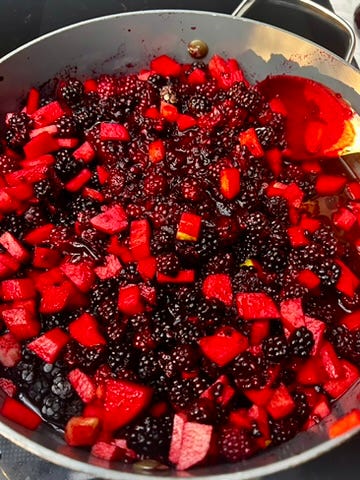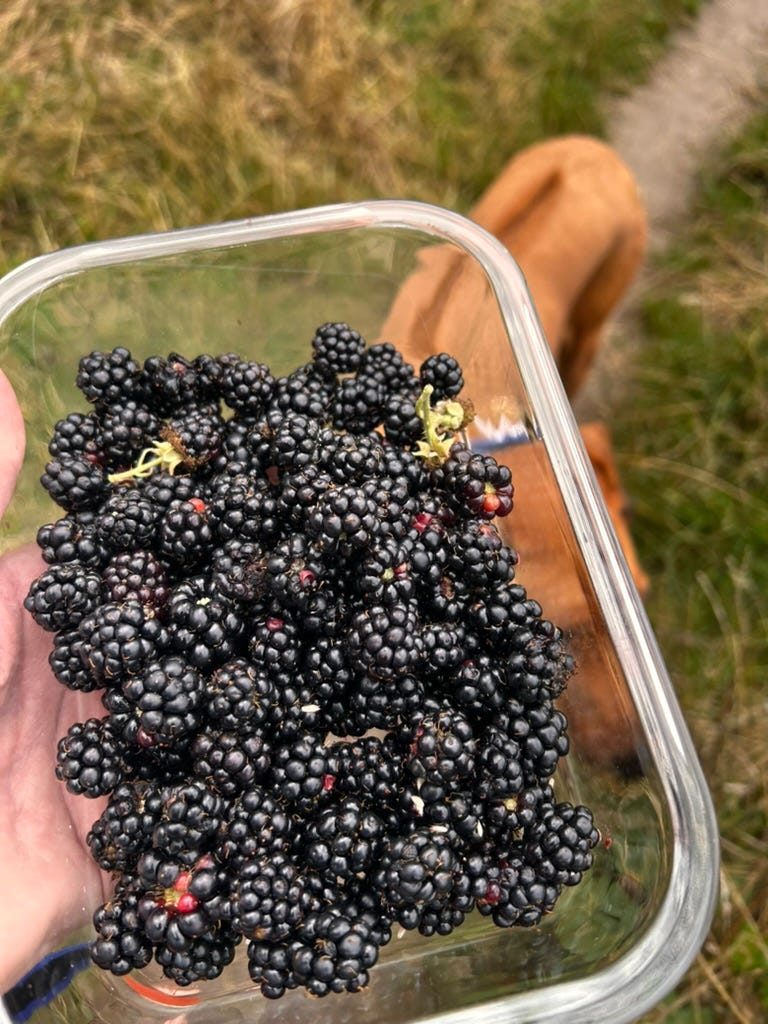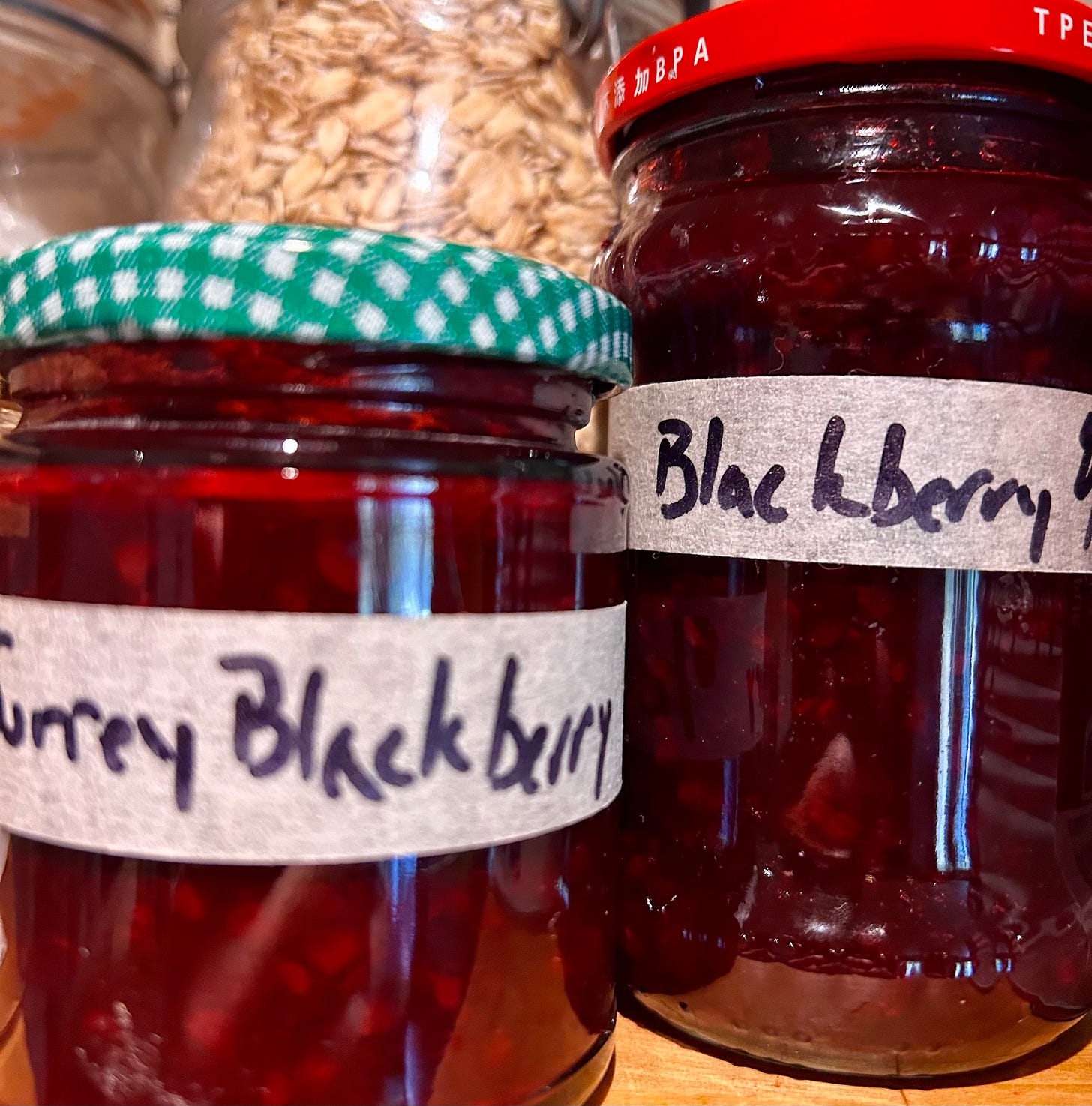The Blackberry Border
A tale of two jams with improvised blackberries in Britain, & deliberate confiture in France
In the UK & France in August, you don’t hunt for hedgerow fruit — you trip over it.
We’re still in England this summer, harvesting blackberries and other summer fruits as a part of our morning routine. It’s one of my favorite things here.
TL:DR: Some stories of jam collecting, then recipes for a French style confiture. It’s really good.
Last week was all about UK-style hedgerow jam — whatever you can grab goes in the jar. In France, where we live most of the year, the fruit’s often the same — brambles, plums, apples, more peaches near us — but the approach can be more structured1.
foraging the lanes
A British woman walked down the narrow lane as I leaned over a bramble, doing my best to minimize my injuries this morning, the dog waited, sniffing at all passers-by.
A lot of the locals don’t seem to pick the berries.
“Oh that’s nice,” she said as she approached. “Perhaps this is nice, but this is not nice for me right now.”
She gave a smile that bared teeth rather than kindness.
What she meant was—
You are a man, alone.
I am a woman, also alone.
This is my peaceful countryside walk.
I live here.
And you are an unwelcome surprise.
Which is fair enough. I am not here to mess with anyone’s routine. Just here for the berries.
I tried to move out of her way without going into the thorns too much. The lanes are narrow. It’s impossible to avoid close encounters.
I lifted the berries to show her my purpose out here.
“Lovely.”
I’m not sure she thought it was lovely.
The dog looked up her eagerly.
She sidled by, adjusted her Lululemon hat and kept walking.
boredcore
We like doing this2. There’s a rhythm — coffee, sunrise, the dog, morning walks, containers of blackberries, scratches. It stops being exciting after a few days, which is when it starts to feel routine, to feel good.
It is, as that woman might say, “lovely.” But it really is.
Blackberries on yogurt. Blackberries on toast. Blackberries eaten over the sink, off the bush, at most hours of the day. The repetition is the point, if there is any point at all.
practical stuff & ID
Bring along a plastic container or two. If you put berries in a bag, you’ll have mush at home. I’ve done it.
Blackberries grow in messy, thorny tangles. The stems are sometimes purplish, the leaves in threes or fives, serrated, a bit like raspberries. The berries start green, then red, then black.
The ripe ones fall into your hand. If you have to tug, it’s not ready.
And if half the village is picking from the same hedge, you’re probably safe to join in.
two rustic styles
Hedgerow jam is really informal. Whatever you’ve got, that goes in. The French also have confiture maison, which is homemade stuff.
Hedgerow jam is all about immediacy. You come home with purple fingers, rinse the day’s haul, and get it cooking before it bruises or molds. There’s not too much of a fixed recipe (there can be) — today’s batch might be half brambles, tomorrow damsons with a handful of windfallen apples for pectin.
French confiture can be precise (though it doesn’t have to be). Fruit is sorted, weighed, matched gram-for-gram with sugar (many UK recipes suggest 1 part fruit to 3/4 sugar).
Ideally, it’s left to macerate overnight and berries can hold their shape. Even without copper pots, there are also just people shoving hot fruit into jars. But the French are very likely using more sugar no matter what. There’s a reason it tastes wonderful.
hedgerow jam – the UK way
This is the “Mixed Bag” method. Improvised, forgiving, and always a little different.
Ingredients
• Mixed fruit: blackberries, damsons, apples, crabapples, wild plums, elderberries — whatever’s ripe
• Sugar — about ¾ the weight of the prepared fruit
• Juice of 1 lemon
• Splash of water
Method
Wash fruit. Peel apples for smoother jam (I always do). Remove stems.
Put fruit, sugar, lemon juice, and water in a large pot. Stir over low heat until sugar dissolves.
Bring to a boil, then simmer until thickened. Test the set on a cold plate — if it wrinkles when pushed, it’s ready.
Jar hot in sterilized jars, label so you remember what it is.
Notes: Crabapples or Bramley apples add natural pectin.
No batch will taste the same twice — that’s the charm.
Musical Interlude
La confiture Les Frères Jacques (1959)
One of the best-known songs from the French vocal quartet Les Frères Jacques (1946–1982). La confiture is a playful roll-call of jams, loaded with double meanings children and adults can enjoy.
I’ve gone with an audio track here — while their famous color-coded leotards and white gloves were their signature, the look hasn’t aged as well as the music. Over their 36-year career, they performed thousands of shows, released dozens of records, a combination of chanson & vaudeville. There’s a bit of mime in there and physical comedy, a style that was once all over French stages but is rarely seen now.

Recipe: Confiture de mûres – a French method
a more deliberate jam than its hedgerow cousin.
Ingredients
• 1 kg blackberries (or a single fruit, sorted)
• 1 kg granulated sugar
• Juice of 1 lemon
• Optional: muslin sachet of apple peels and cores for pectin
Method
In a glass or ceramic bowl, layer berries with sugar and lemon juice. Cover, leave to macerate overnight. Or at least a few hours.
This is a VERY important part of the process: do not mix the fruit and sugar together in the copper pan - only add once already mixed.
Pour fruit and syrup into a wide copper jam pot (bassine à confiture) or heavy-bottomed pan. Add a pectin packet, if using.
Bring to a boil over medium-high heat, stirring often. Copper conducts heat evenly, reducing cooking time and preserving bright color and flavor.
After 15–20 minutes, test the set on a cold plate. Remove pectin sachet.
Jar hot, label neatly.
Notes: Copper isn’t essential, but it makes a difference — faster evaporation, even heat, jewel-toned results. I never used to believe it, but it’s really clear to see and taste.
I’d love to hear what you think - if you have any recipes or techniques that work for you. Really, I am imprecise and sloppy, reusing whatever jars are around. I made confiture on a friend’s farm and we made 200 or so identical jars with days of batches going through his copper pot.
I like the easy way. You?
related posts
A Jar of England Summer
England in August tastes like blackberries and I have the arm scratches to prove it.
The Invasive Edges Where Familiar Things Grow
In France, there are an increasing number of wild spaces, but the country is still mostly partitioned into very controlled natural spaces. Our old neighborhood had blocks and blocks of Very Square Trees that had a lot of work put into them to keep them that way. But this country has been divided up, cultivated, owned, worked, and more for hundreds of ye…
To be clear, both countries have formal and informal jams and jellies, but I am not writing a The History of Jams and Franco-English Relations…
I keep meaning to write about this: boredcore, like a purposeful pursuit of calm quiet, chill routines without too much variation. That feels like a vacation for me.










PS we do let it macerate overnight and then it makes its own juice.
That's a Great idea to use apple cores and peels. I've saved lemon seeds over a time too.
I didn't know our copper pan helped with the color of the jam.